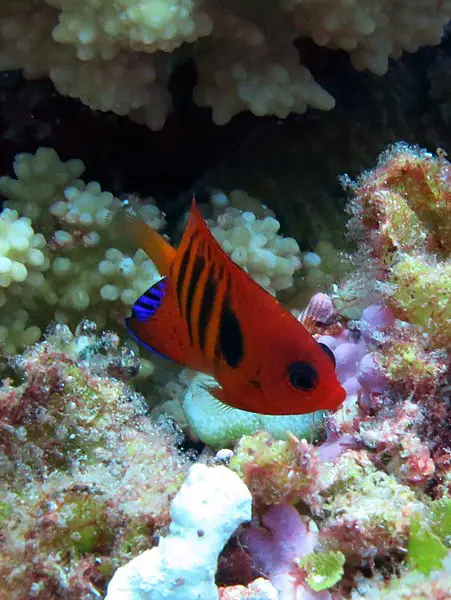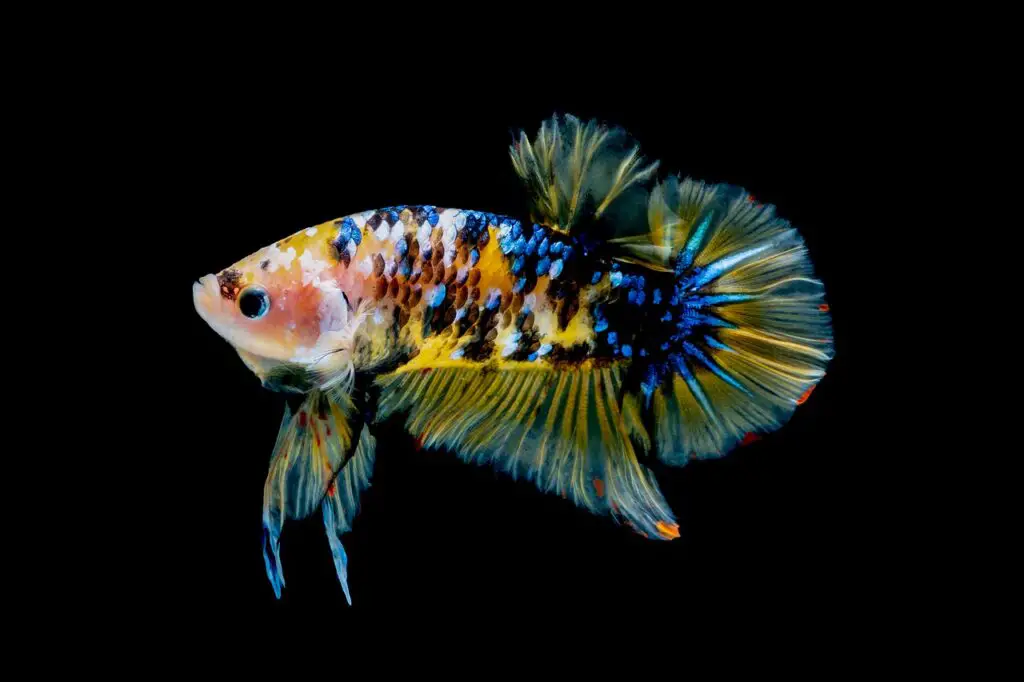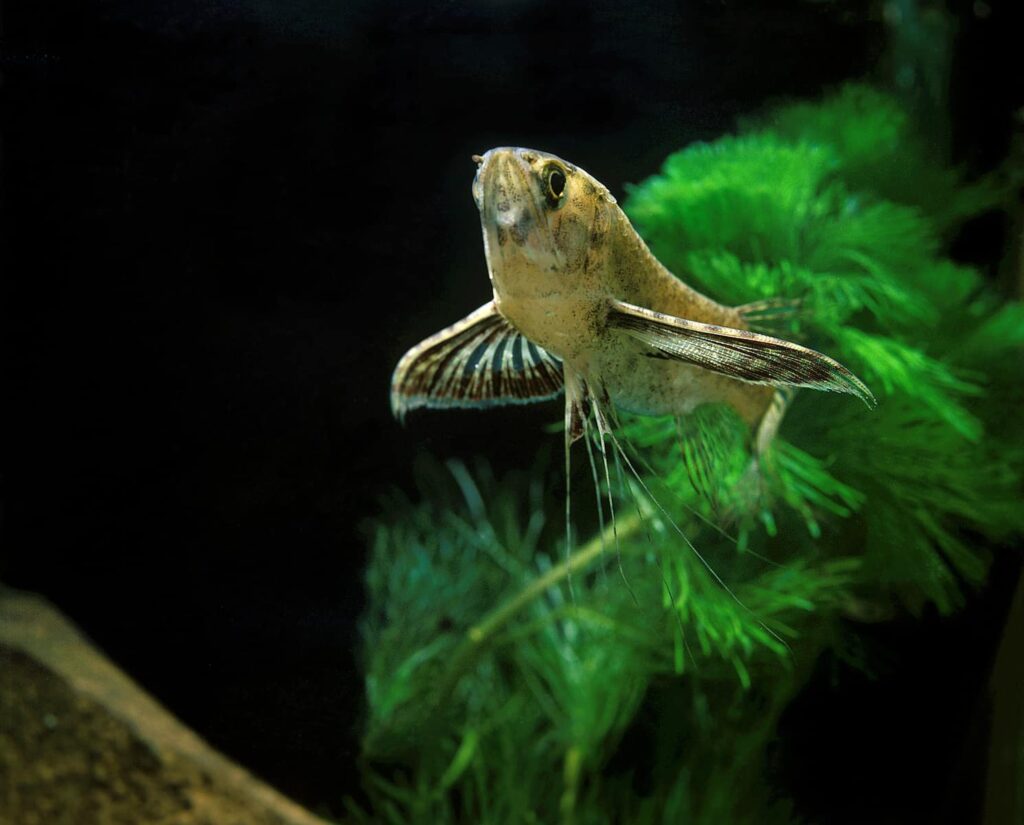The flame angelfish is a type of dwarf angelfish and tends to be one of the most popular saltwater tropical fish available for you to adopt for your tank. They tend to be rarer than some of the other angels out there, but that doesn’t mean you won’t be able to find them at reasonable prices!

This flame angelfish guide will take you through what you need to know about this species, how you can care for them, and what you’ll need to do to make your tank flame angel perfect.
- Fish Lifespan: Up to 7 Years
- Tank Size: Up to 70 Gallons
- Water Temperature: Between 72F and 78F
- pH: Between 8.1 and 8.4
- Hardness: Between 8 and 12 dKH
- Compatibility: Compatible with Damselfish, Clownfish
- Fish Size: Up to 4 Inches
How do you take care of flame angelfish?
The flame angelfish is a very common sight in some of the more brimming saltwater communities, however, it’s not always the easiest angel to get hold of. This is an angelfish that has lovely colours and which is guaranteed to add more than a splash of character and charm to your saltwater aquarium.
These fish don’t tend to be that aggressive providing you give them the best start. You’re going to need a fairly big tank regardless of the general gallons to fish ratio, meaning that bigger is better in this case. These fish tend to hail from around Christmas Island and the Marshall Islands, which means warm to hot waters are great. Anything higher than 78F, though, is a no-no.
Flame angels will get on well with other fish though they can bully smaller critters given half the chance. Therefore, it’s normally a good idea to add them into your tank last of all. As omnivores, these fish are also likely to eat smaller critters in the aquarium, meaning that if you have smaller fish or even certain invertebrates, the flame angel is going to take a nibble.
They tend to grow to mid-size proportions compared to other common saltwater fish, and they can be tricky to look after when it comes to tank water levels. They are extremely sensitive to copper, for example, meaning you must make sure that that you keep this below 0.15 ppm.
The flame angel can also be hard to breed. That’s because, like some clownfish, they can change from male to female, and there’s actually no real way to tell the genders apart with the naked eye. Therefore, if you do want to breed flame angels, you’re probably going to need a fair amount of luck on your side!
Are flame angelfish aggressive?
As with other angelfish, the flame angel can be territorial, and it can have a habit of bullying and even eating smaller creatures.
However, that doesn’t make it a bad pet at all – they are very colourful characters and will tend to go about their own business providing you have a large enough tank with plenty of nooks and crannies that they can hide in from time to time.

Again, it’s probably worth bringing flame angels into your tank last of all. Like damsels, they can get a bit of a bad reputation, but it’s all about making sure you balance things out.
We’d probably not advise taking on flame angels right away if you are new to saltwater fish keeping – mainly because you’re going to need to be really careful with their water. Add in the fact that they don’t always play nice with other fish, and you’re going to have a bit of a challenge on your hands right away.
That said, place them in a tank with fish of similar size and temperament, and you’ll have the best possible start.
How much does a flame angelfish cost?
The price of flame angels will vary from aquarium to aquarium, however, a good going rate can tend to be around $100.
This is because these angels are not necessarily common. They only really swim around the Marshall Islands and Christmas Island, making them pretty exclusive. They are not the rarest of breeds to put in your tank, but they are still highly sought-after.
A fish keeper with flame angels in their tank is likely to be one that takes their aquarium building very seriously! This is the mark of a fish enthusiast who is willing to put the time into looking for the rarer breeds and who doesn’t mind giving plenty of time to actively managing their water levels.
Therefore, novices will probably do best saving their pennies initially regardless of how gorgeous these fish can be! It may be more prudent to look for clownfish, for example, to begin with.
Are Flame Angelfish Reef Safe?
On paper, they are reef fish, but they tend to nibble and feed on coral and reef, meaning they may not be the most reef safe creatures you can introduce to your tank. If your community relies on coral reef, the flame angel might make things a bit tricky.

However, this isn’t always a guarantee. Flame angels simply like nipping at things. They are very curious, confident creatures, though like many other saltwater breeds, they do also enjoy poking in and out of hiding places every once in a while. Everyone needs personal space from time to time, we’re sure you’ll agree!
Flame angels are sensitive to water changes, so it is certainly worth making sure that the coral reef you have in place already is going to be fully compatible with their needs and demands. There’s nothing to say it won’t be, but caution is key.
What size tank does a flame angel need?
Flame angels generally need bigger tanks than most as a result of their temperaments. Experts suggest around 70 gallons is a good idea.
This is going to give a small collection of flame angels enough room to swim around and establish themselves, and it also means you should be able to set up a host of hiding places and nooks for them to dive in and out of.
The general rule for tank sizing tends to be ‘2 gallons for every inch of fish’. Keep in mind that this is a minimum ratio. The best aquariums are those which offer lots of space – meaning that there will be more room for them to swim around and to establish their own territories. This is always a good idea if you want to keep your tank as peaceful as possible.
How long do flame angelfish live?
Flame angelfish can generally live for between 3 to 7 years with basic care. However, they can live for longer.
Long-living flame angels are those which have perfect tank conditions. Getting a flame angel to older than 10 years old is an amazing achievement, and not one we would normally recommend that novices or starter tank owners take on right away.

If your flame angel lives for at least 3 years and it’s your first saltwater tank, you’ve done amazingly well.
It’s worth keeping in mind that the flame angel can struggle with some skin diseases, some of which have the potential to cut down their lifespan. Therefore, always be careful to treat your flame angels carefully and to be very cautious with other fish you add to your tank.
What do flame angels eat?
Flame angels are omnivores, which generally means that anything goes – however, it’s normally best to feed them on quality meat and spirulina, amongst other things.
One of the best parts to owning flame angelfish is the fact that they will happily chow down on your tank’s algae, making the community safer for all.
However, don’t just assume that your flame angels are just going to subsist on this diet alone. They are going to need quality meat so that they avoid munching on any creatures smaller than themselves in the same tank!
Frozen shrimp tends to be a good choice for this fish – however, you’ll be able to get more information from your vet or your local aquarium experts.
Should I adopt a flame angel?
Flame angels really are collector’s creatures thanks to their amazing marking variations and their relatively exclusive habitat. If you can find one, by all means adopt one!
However, we do recommend that you have a few years of tank keeping experience behind you before you do. This is because maintaining water quality for these fish is not always easy.
They are great fun to look at and will do well with other fish providing you are careful with the community balance. This means a keen, experienced fish keeper will need to keep a close eye on what’s happening in the water to keep their angels living for as long as possible.
Make sure to get a few years of tank keeping under your belt first, and there should be no reason why you can’t take on a flame angel or two, successfully, in the months and years to come. Just be willing to put in the work!



